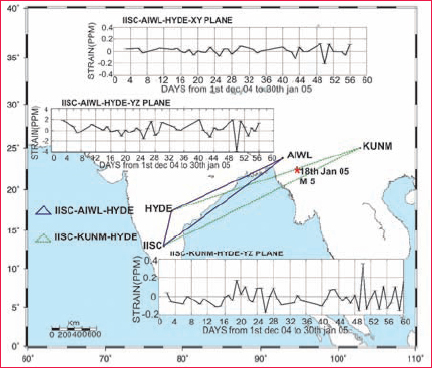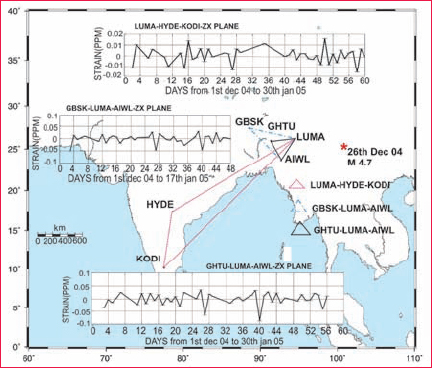| Mycoordinates | |
Estimates of anomalies in triangular area
Results and discussionsThe results indicate no significant change in areal strain due to Dec 26, 2004 mega earthquake. This may be attributed to the fact that these sites are quite distant from the rupture plane. This can also be attributed to the almost constant relative shift in coordinates of the stations. But these results do show significant anomalies in the daily triangular area for some of the triangles for a particular day. After a detailed investigation we could map these anomalies to the local seismic events that have occurred within these triangles, the details of which are given below. The GAUHATIKUNMING- AIZWAL (GHTU-KUNMAIWL) shows ( Figure 2) an areal strain of ~0.28 ppm on 9th Jan 2005 in XY projection plane where the average anomaly fluctuates between ±0.1 PPM. Similarly, all the three plane projections (XY, YZ and ZX) of GAUHATI-LUMAMI-AIZWAL (GHTULUMA- AIWL) show large anomalies of 0.2 PPM, -2 PPM and –0.1 PPM on 9th Jan 2005 where the threshold lies between ±0.1 PPM, ±1 PPM and ±0.025 PPM respectively. This may be due to the M4.7 shallow earthquake at 25.12ºN 98.86ºE with depth 36 km which occurred on 7th Jan 2005 [http:// eqint.cr.usgs.gov/neic/cgi-bin/epic/]. This event is within GHTU-KUNMAIWL triangle and closer to GHTULUMA- AIWL triangle (Figure 2). This indicates possible contraction in GHTUKUNM- AIWL and GHTU-LUMAAIWL triangular area (XY plane). Similarly, IISC-AIWL-HYDE (Bangalore- Aizwal-Hyderabad) shows (Figure 3) a dilatational strain of –0.22 PPM and –4.25 PPM in XY and YZ planes on 19th Jan 2005 where the threshold lies within ±0.1 PPM and ±2 PPM respectively. A compressional strain of 0.38 PPM is traced in YZ plane of IISC-KUNM-HYDE on 19th Jan 2005. This may be due to M5.0 earthquake (Depth = 104 km) at 22.97ºN 94.70ºE on 18th Jan 2005 [http://eqint. cr.usgs.gov/neic/cgi-bin/epic] in Central Burman Molasse Basin (Figure 3). The Central Burman Molasse Basin lies within IISC-KUNM-HYDE triangle and closer to IISC-AIWL-HYDE triangle. Figure 2: anomalies in the daily triangular area of GHTU-lUMA-aIwl triangle, GHTU-KUNM-AIWl triangle and the corresponding strain (PPM) Figure 3: anomalies in the daily triangular area of IIsc-aIwl-hyde triangle, IISC-KUNM-HYDE triangle and the corresponding strain (PPM) All triangles involving Lumami (Figure 4) at one of their vertices such as LUMAHYDE- KODI, GBSK-LUMA-AIWL, and GHTU-LUMA-AIWL show a slightly high dilatational strain on 27th Dec 2004 in ZX projection plane. The probable source of this deformation is M4.7 tremor of shallow depth 66 km at 24.85ºN 101.69ºE which occurred very close to Lumami and Kunming on 26th Dec 2004 (Figure 4). The error values have been computed for the areal strain computations of all the triangles and are found to be insignificant when compared to the anomalies. The rest of the triangles do not show any significant daily change ratio. Figure 4: Anomalies in the daily triangular area of LUMA-HYDE-KODI triangle, GBSK-LUMA- AIWL triangle, GHTU-KUNM-AIWL triangle and the corresponding strain (PPM) ConclusionAs the relative change in triangular area between stations gives dilatational strain which is more sensitive than the relative change in coordinates, such a study can be utilized for a better understanding of deformation of a region due to local tectonic events. This analysis when done on a daily basis at all GPS permanent sites would generate long time series of strain in XY, YZ and XZ planes which would give more insight in to the deformation regime in the region. These strain changes References * Bilham, R., Engdahl, R., Feldi, N., Satyabala, S. P., 2005, “Partial and Complete Rupture of the Indo-Andaman Plate Boundary 1847-2004”, Seismological Research Letters, 76, pp. 299 – 311. |
||||||||||||||||||||||||||||
|
||||||||||||||||||||||||||||
|
Pages: 1 2


















 (No Ratings Yet)
(No Ratings Yet)



